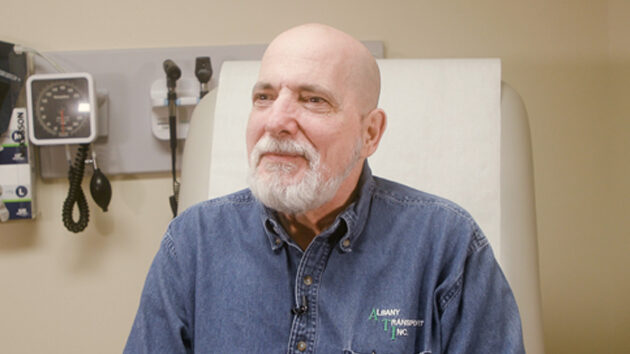How One COPD Patient Got Off Oxygen – and Got His Life Back
Mark Faber spent more than ten years on oxygen as chronic obstructive pulmonary disease (COPD) blocked airflow to his lungs, making him constantly feel like he was either drowning or suffocating.
The disease was debilitating: He couldn’t walk upright or take deep breaths. He would end up doubled over trying to catch his breath from the exertion of making the bed. Unable to drive because of coughing attacks, anxiety, and light-headedness, he let his driver’s license expire and stopped riding his motorcycle. Leaving home meant his wife would have to load his oxygen tanks and wheelchair into the car.
Yet seeing the 63-year-old Faber today, it’s difficult to imagine how hard daily activities had been for him. He bursts with pride as he talks about how he brushed snow off the car, brought four bags of groceries inside, and cooked a meal – all of which would have been unheard of just a few months ago.
“I’m almost to the point where I was before being on oxygen,” he said. “It’s like having ten years of the disease taken off my body.”
Endobronchial Valve Placement Procedure
In August 2023, Faber’s pulmonologist referred him to Nagendra Madisi, MD, an interventional pulmonologist at Albany Medical Center. That October, Dr. Madisi used a bronchoscope – a thin tube inserted into the lungs via the nose or mouth – to place three endobronchial valves in Faber’s left lung. Four additional valves were placed in his right lung in November, resulting in dramatic improvements to his breathing and overall quality of life.
Endobronchial valve placement by bronchoscopy is a minimally invasive, nonsurgical treatment for patients with severe COPD, including advanced emphysema. Patients at Albany Medical Center receive either Zephyr valves or Spiration valves, both of which are FDA-approved.
“These one-way valves help air come out of the diseased, overinflated part of the lung,” explained Dr. Madisi, who has performed more than fifty endobronchial valve placement procedures at Albany Medical Center. “The diseased part slowly deflates, which helps relieve pressure on the diaphragm and allows people to take deep breaths again.”
An Immediate Impact
Many patients feel the positive impacts of the procedure immediately or after only a few days, noted Dr. Madisi. “And they keep improving for six to eight weeks, until they see the maximum benefit at approximately three months,” he added.
According to Dr. Madisi, his endobronchial valve patients have been able to take deeper breaths, walk longer distances, and exercise more. “Their quality of life changes abruptly because they’re not wheelchair bound anymore,” he said. “It’s really a life-changing procedure.”
Faber – and those who knew him before the procedure – agrees. “Christmastime came around, and my family was looking at me like I was Lazarus,” he said.
Candidates for the Procedure
To be considered for the endobronchial valve placement procedure, patients must have advanced COPD; be on maximum medical therapy that no longer provides relief for their COPD; refrain from smoking for at least four months prior to the procedure; have a Pulmonary Function Test with an FEV1 between 15 percent and 45 percent; and have air trapping.
Less than three months after his procedure, Faber says he feels like a new person. He even plans to renew his driver’s license and get back on his motorcycle.
“There are really no words to describe it,” he said. “It’s like getting your life back.”
To schedule a consultation about the endobronchial valve placement procedure at Albany Medical Center, call 518-262-5196.
